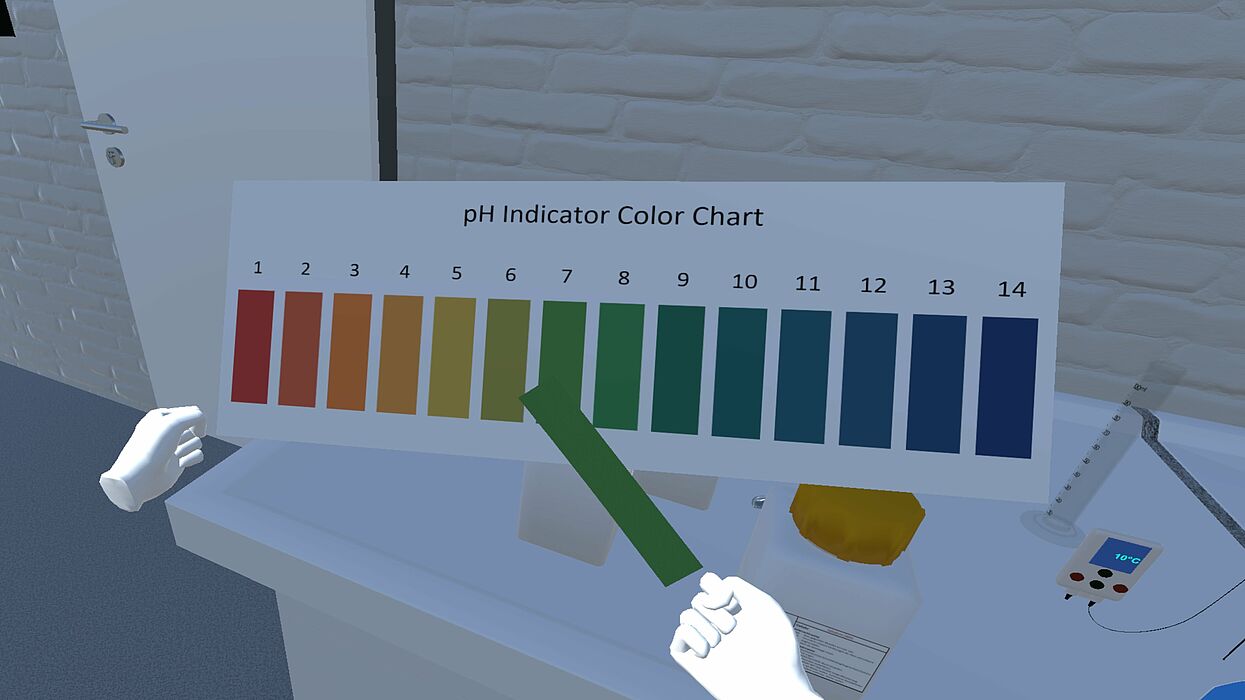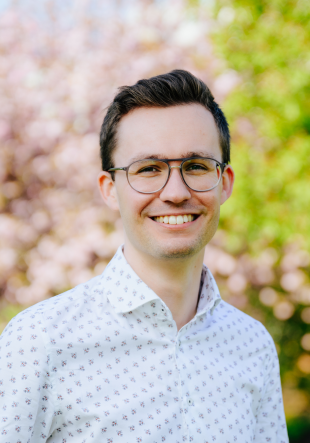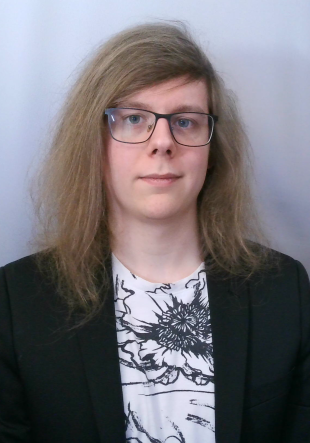Students at Paderborn University learn the basics of practical laboratory work in the VirtuChemLab using VR goggles and a controller
A flame hisses from the Bunsen burner, water boils in a beaker and measuring instruments buzz and flash in the background. Hendrik Peeters weighs a portion of sodium hydroxide and observes the temperature curve as the substance dissolves in water. It all looks amazingly real, but Peeters, a research assistant in the field of chemistry didactics at Paderborn University, is in a virtual chemistry lab. In front of him are shelves with test tubes, bottles of chemicals and the familiar workbench with all the necessary equipment. For the past two years, students at the university have been trialling the "VirtuChemLab", in which experiments can be carried out in the future regardless of time and place, enabling them to learn the basic processes of practical laboratory work. This is made possible by the use of virtual reality (VR).
Interacting with the virtual environment using controllers
"It's impressive how realistic everything looks. You feel like you're really in the lab, except that you have more freedom here," says Peeters as he closes the gas supply to the burner with one hand. He can interact with his virtual environment using controllers that precisely record his hand movements. "Through various experiments, the students learn how chemical processes take place and how substances react with each other. One example is the dissolution of sodium hydroxide in water, where the temperature and pH value change caused by the dissolution process can be measured," explains Jan-Luca Hansel, research assistant in the "Theory of Distributed Systems" department at the Institute of Computer Science, who is leading the further development of the virtual laboratory as part of the "VR@UPB" project.
The basic idea of "VR@UPB" is to create the infrastructure for a virtual campus at various levels, in which teachers and students can get involved. "Laboratory internships are an essential part of science degree programmes. However, especially at the beginning, it becomes apparent that first-year students come to university with different practical experiences from school. The virtual chemistry lab aims to address this discrepancy," explains Peeters. Virtual reality also offers exciting new opportunities for everyday university life outside of chemistry. "In addition to applications such as our virtual laboratory, it would also be conceivable, for example, to visit virtual replicas of distant or ancient places in seminars. This makes topics more tangible and is certainly a welcome change from reading texts," says Hansel. Funded by the university to the tune of around 957,000 euros, the project brings together expertise from the fields of chemistry, chemical didactics, computer science, English studies, media studies and the Centre for Information and Media Technology Services (ZIM).
Experiments with almost all chemical elements
In principle, experiments with almost all chemical elements are possible in the virtual laboratory. This means that experiments on hydrogen could also be realised in the future. For example, a virtual Hofmann decomposition apparatus could be used to carry out the electrolysis of water to produce hydrogen - a forward-looking topic. Peeters outlines a vision of the experiment: "First, the apparatus is filled with diluted sulphuric acid to increase the electrical conductivity. After connecting the electrodes to the power source, the students switch on the power supply. Small bubbles immediately begin to rise - a sign that oxygen is being produced on one side and hydrogen on the other. With a little skill, the hydrogen can then be poured into a test tube and carefully guided to the burner flame. A soft 'plop' confirms that it is hydrogen - the oxyhydrogen test was successful."
Collaboration in virtual space
To make the laboratory conditions even more realistic, there is a multiplayer mode in the "VirtuChemLab". This allows several students to work in the virtual lab at the same time and be supported by teachers. They can communicate with each other via the microphones and headphones built into the VR goggles as if they were standing next to each other. There is also a virtual seminar room for meetings, presentations and exchanging documents. Users can also add new test sequences without prior programming or software knowledge. In the future, there will also be a mechanism with which the VR system can interactively respond to students' actions in the lab in the form of feedback or assistance. "The fact that you don't have to tidy up and clean the workbench and materials, but simply end the programme, is certainly also an advantage," says Peeters with a smile and takes off the VR glasses.
This text has been translated automatically.



